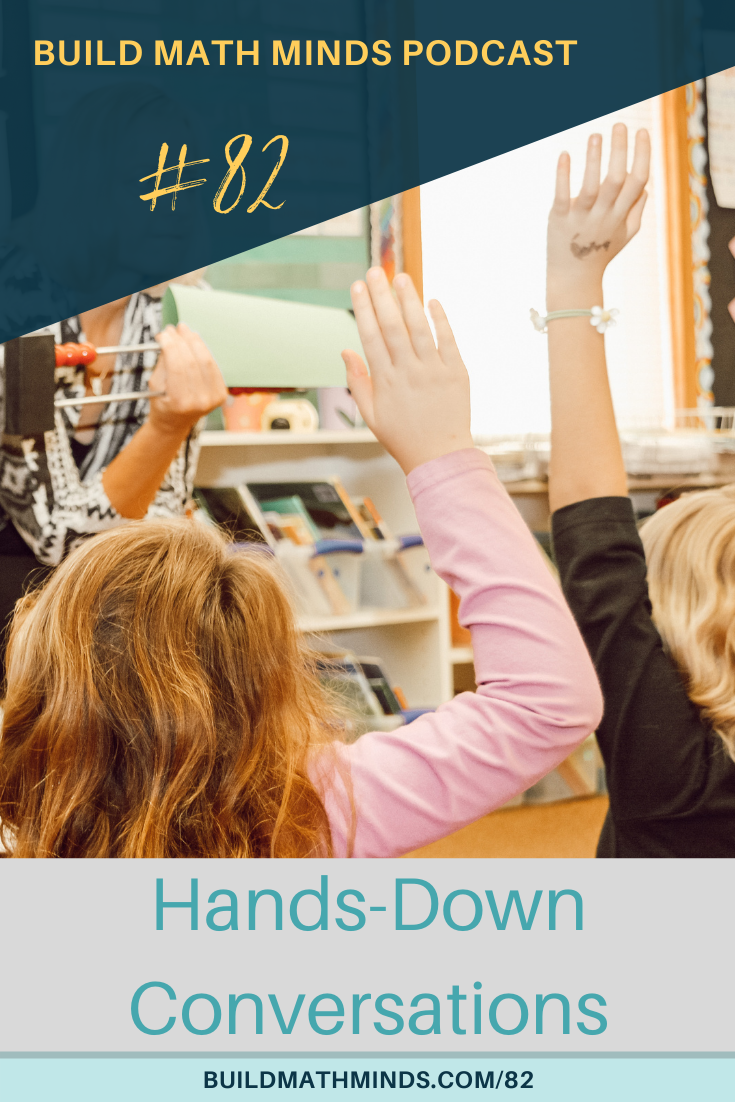Resources mentioned in this episode:
Hands Down Speak Out: Listening and Talking Across Literacy and Math K-5 by Kassia Omohundro Wedekind and Christy Hermann Thompson
Become a member of the Build Math Minds PD site
**Use the code 21STEN10 to get 10% off the book through the Stenhouse website. (US Shipments Only)**
Welcome fellow Recovering Traditionalists to Episode 82. Today we are looking at how to have Hands-Down Conversations.
How many of you were expected to raise your hand before you spoke in school? I did. Even my own kids do now in their classrooms. I know this not because I’m in class with them but at the dinner table we will be having a conversation and one of them will raise their hand for a turn to speak.
When I was in the classroom, I had students raise their hands to speak because classroom conversations can get out of hand and unruly very quickly. So I was intrigued when I saw the book Hands Down Speak Out: Listening and Talking Across Literacy and Math K-5 by Kassia Omohundro Wedekind and Christy Hermann Thompson.
We’ve all heard the saying “The person who does the talking, does the learning,” in reference to encouraging teachers to stop doing all the talking and let the kids talk more. When kids get to talk, it empowers them to be in charge of their own learning. I think we all get that in theory but how to put that into practice is hard.
In their book, Kassia & Christy focus on helping the reader implement the use of Hands-Down Conversations in order to allow the kids to be the ones doing the talking and thus, the learning.
On pages 3-4 they write:
“Hands-Down Conversations are, most simply put, conversations that flow among students without the use of hand-raising, and in which the teacher is not the primary speaker. The structure of a Hands-Down Conversation is intentionally simple and predictable so that the real work of the conversation is focused on constructing meaning, not on following a set of complicated rules.
In Hands-Down Conversations students gather in a circle facing one another. The teacher sits just outside the circle, listening deeply, taking notes, and sometimes entering the conversation briefly to facilitate.
There are three basic guidelines for Hands-Down Conversations:
- No hands. Listen for the space to slide your voice into the conversation.
- One voice at a time (more or less!).
- Listen closely to everyone’s ideas.
Hands-Down Conversations are designed to deepen the level of classroom discourse by creating conditions in which students take on a greater ownership and have more decision-making power in conversations. The students’ ideas lead the conversation. And yet, while the teacher’s voice is much less present in Hands-Down Conversations than in traditional classroom discourse, the role of the teacher in facilitating the meaning-making remains critical.”
If you have ever wondered how to allow more discourse and participation without your classroom seeming like a free-for-all, then this book is for you. I’ll link to the book over at buildmathminds.com/82 and there is a discount code on that page for you to use when you purchase the book from Stenhouse Publishing.
Subscribe and Review in iTunes
Hey, are you subscribed to the Build Math Minds Podcast, yet? If you’re not, make sure to do that today because I don’t want you to miss any episodes! Click here to subscribe to the podcast in iTunes.
While you’re there, don’t forget to leave a review on iTunes too. I would love to know your thoughts and how we can make sure that we give you content that you will really enjoy.
To leave a review, head over to iTunes and click on “Ratings and Reviews” and “Write a Review.” I can’t wait to hear your thoughts about the podcast.





Quick heads up – I can’t get the discount code to work, but bought the book anyway!
Thanks for letting us know.
Today is Feb. 24, 2021
I just called Stenhouse Publishing to request a quote for the book, “Hands Down Speak Out: Listening and Talking Literacy…Math K-5”
Salesperson Danny says they always offer educators 20% discount.